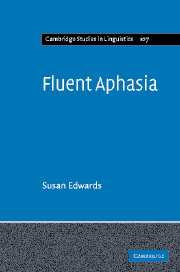Book contents
- Frontmatter
- Contents
- List of figures
- List of tables
- Acknowledgements
- Introduction
- 1 Fluent aphasia: identification and classic descriptions
- 2 Descriptions of fluent aphasia
- 3 Assessment and fluent aphasia
- 4 Connected fluent aphasic speech
- 5 Non-fluent and fluent aphasic speakers. What are the differences?
- 6 Comprehension and processing problems in fluent aphasia
- 7 The manifestation of fluent aphasia in one speaker
- 8 Some concluding thoughts
- References
- Index
1 - Fluent aphasia: identification and classic descriptions
Published online by Cambridge University Press: 22 September 2009
- Frontmatter
- Contents
- List of figures
- List of tables
- Acknowledgements
- Introduction
- 1 Fluent aphasia: identification and classic descriptions
- 2 Descriptions of fluent aphasia
- 3 Assessment and fluent aphasia
- 4 Connected fluent aphasic speech
- 5 Non-fluent and fluent aphasic speakers. What are the differences?
- 6 Comprehension and processing problems in fluent aphasia
- 7 The manifestation of fluent aphasia in one speaker
- 8 Some concluding thoughts
- References
- Index
Summary
Uh we're in the in the kermp kerken kitchen in in the kitchen and there's a lady doing the slowing. She's got the pouring the plate watching it with with um. The water is balancing in the sink the (X) of the sink and the water is pouring all over the bowing bowing all over it.
Introduction
The text quoted above is a small section of a person's description of a picture of a woman washing dishes. The speaker has fluent aphasia. Fluent aphasia is an acquired language disorder that arises subsequent to brain damage. This chapter provides an introduction to the condition and a historical perspective.
Fluent aphasia is a distressing condition for the person who has it and for relatives and friends of that person. It is a relatively common type of aphasia, although there is little published about it compared with the literature on Broca's aphasia. Kertesz (1982:7) described Wernicke's aphasia as ‘a common aphasic impairment’ and Wallesch, Bak and Schulle-Mouting (1992) found that the majority of patients who survived for one year post-trauma had fluent aphasia. It is also one of the most common types of aphasia found in the first few weeks post trauma (Blanken, Dittmann, Grimm, Marshall and Wallesch 1993).
- Type
- Chapter
- Information
- Fluent Aphasia , pp. 5 - 31Publisher: Cambridge University PressPrint publication year: 2005



